After falling another 1% on Friday to take its week-to-date losses above 10%, Bitcoin (BTC) is now oversold, according to the widely followed 14-Day Relative Strength Index (RSI) indicator. BTC/USD was last changing hands in the $20,100s, having dipped as low as the $19,500s earlier in the session, with its RSI last just above 28.
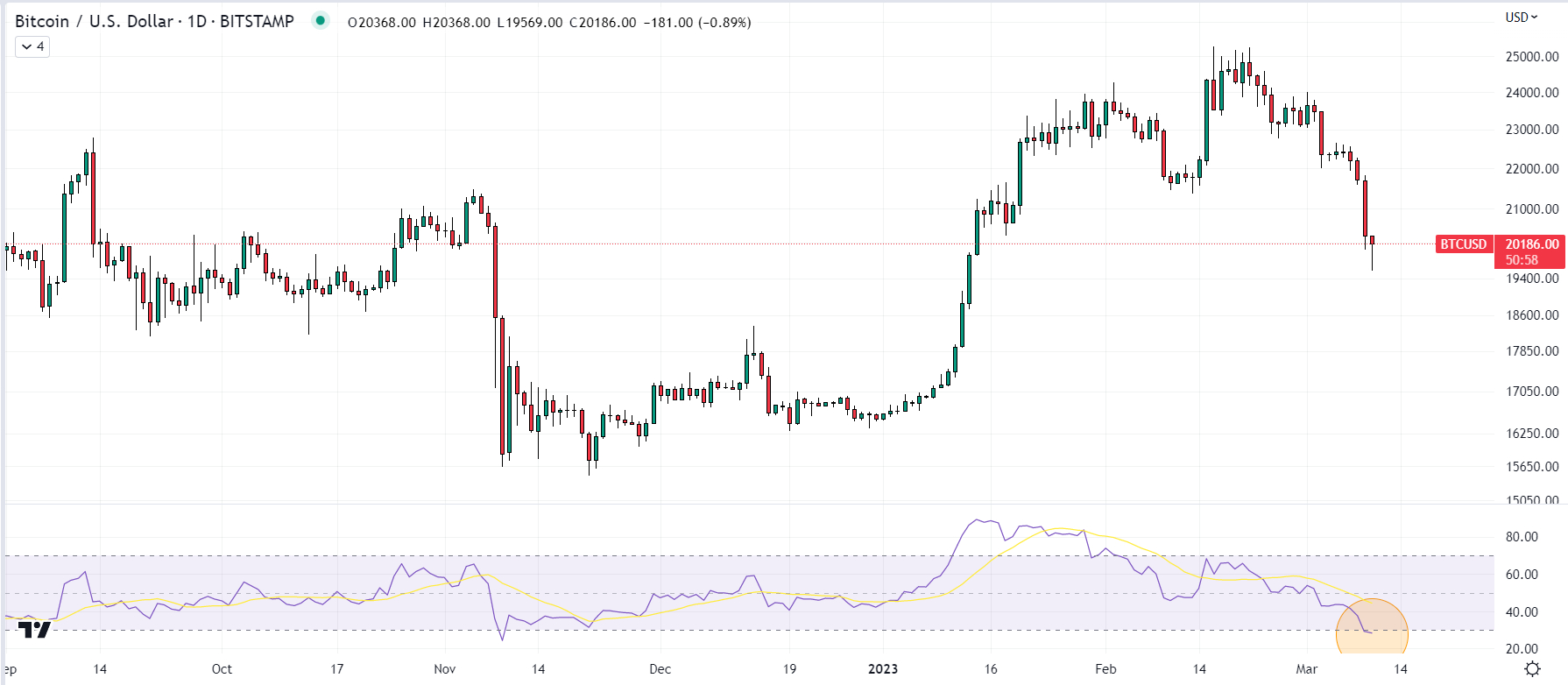
An RSI score of less than 30 is widely viewed as indicating that market conditions have become oversold in the short term. Meanwhile, an RSI score of above 70 is viewed as indicating market conditions have become over-bought.
The last time Bitcoin’s RSI fell below 30 was in the immediate aftermath of the collapse of cryptocurrency exchange FTX back in November. Bitcoin’s RSI entering oversold territory is often a lead indicator that a recent sharp drop may be about to end and a period of consolidation at lower price levels may be incoming.
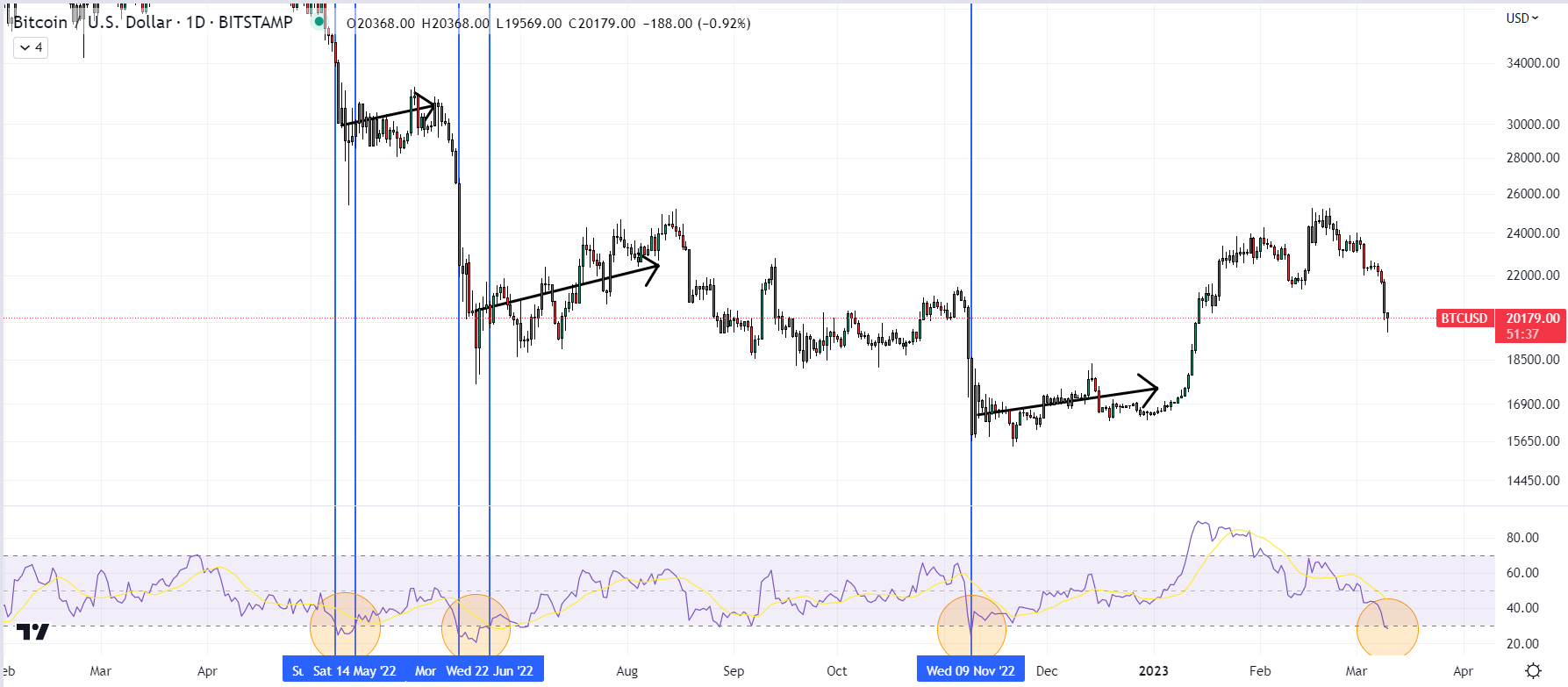
Bitcoin’s RSI falling into oversold territory comes after a so-called “bearish divergence” earlier in the year. This is where the RSI starts posting lower highs, despite prices remaining in an uptrend.
In the most recent example, Bitcoin’s RSI hit a high of 86 on the 13th of January when BTC/USD was just breaking above $20,000, before continually posting lower highs as the Bitcoin price advanced above $25,000 over the course of the next few weeks.
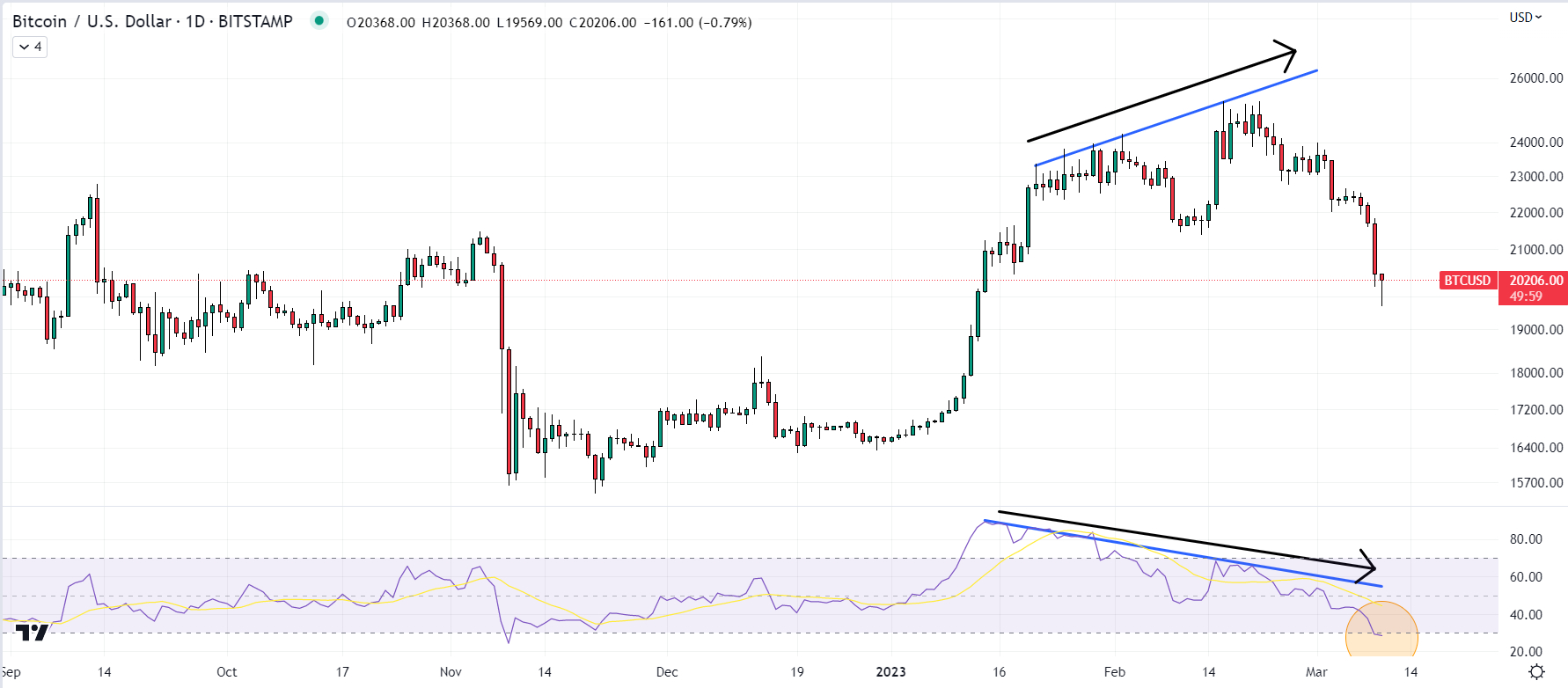
Some traders view a bearish divergence of the RSI with the underlying price as an indicator that bullish price momentum is waning. And that certainly seems to have been the case in the last few weeks.
200DMA, Realized Price Offer Vital Support
Bitcoin’s bounce back above the $20,000 level on Friday suggests appetite in the market to defend the key 200-Day Moving Average and Realized Price levels in the $19,700-800 region remains strong.
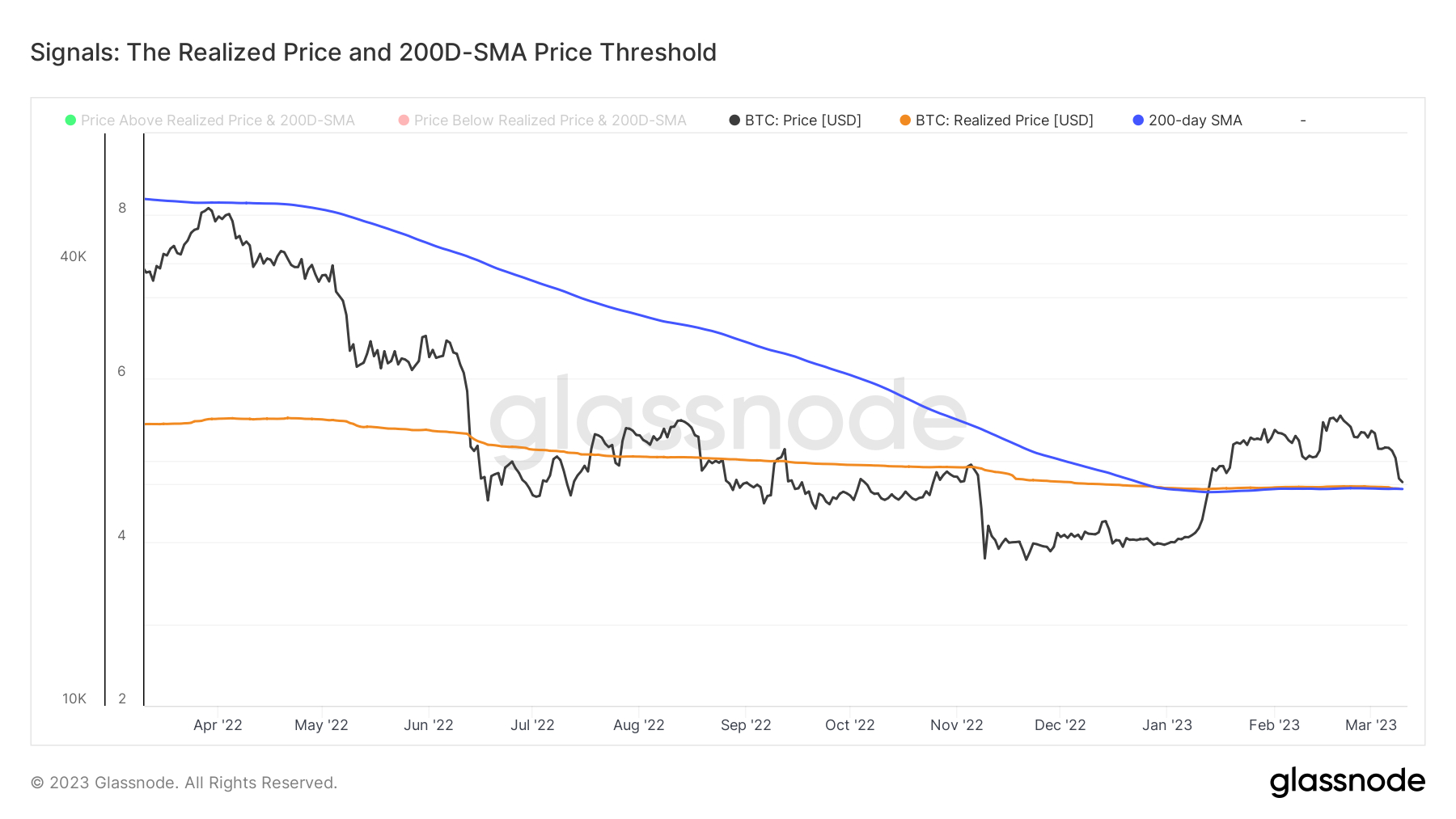
For reference, the Realized Price is an on-chain metric, calculated by taking the average price at the time when each circulating Bitcoin last moved – it’s a proxy for the average price the market paid for each Bitcoin.
Both levels are widely followed by cryptocurrency and traditional asset investors alike. A decisive break above these levels, as happened earlier in the year, is seen as a strong sign that the market’s near-term momentum has shifted in a positive direction.
Conversely, failure to break above the 200DMA (or Realized Price) can be viewed as a sign that the market “isn’t ready” to embark on a new bullish trend, and aggressive reversals are often seen. That was the case for Bitcoin when it failed to break above its 200DMA back in late March 2022.
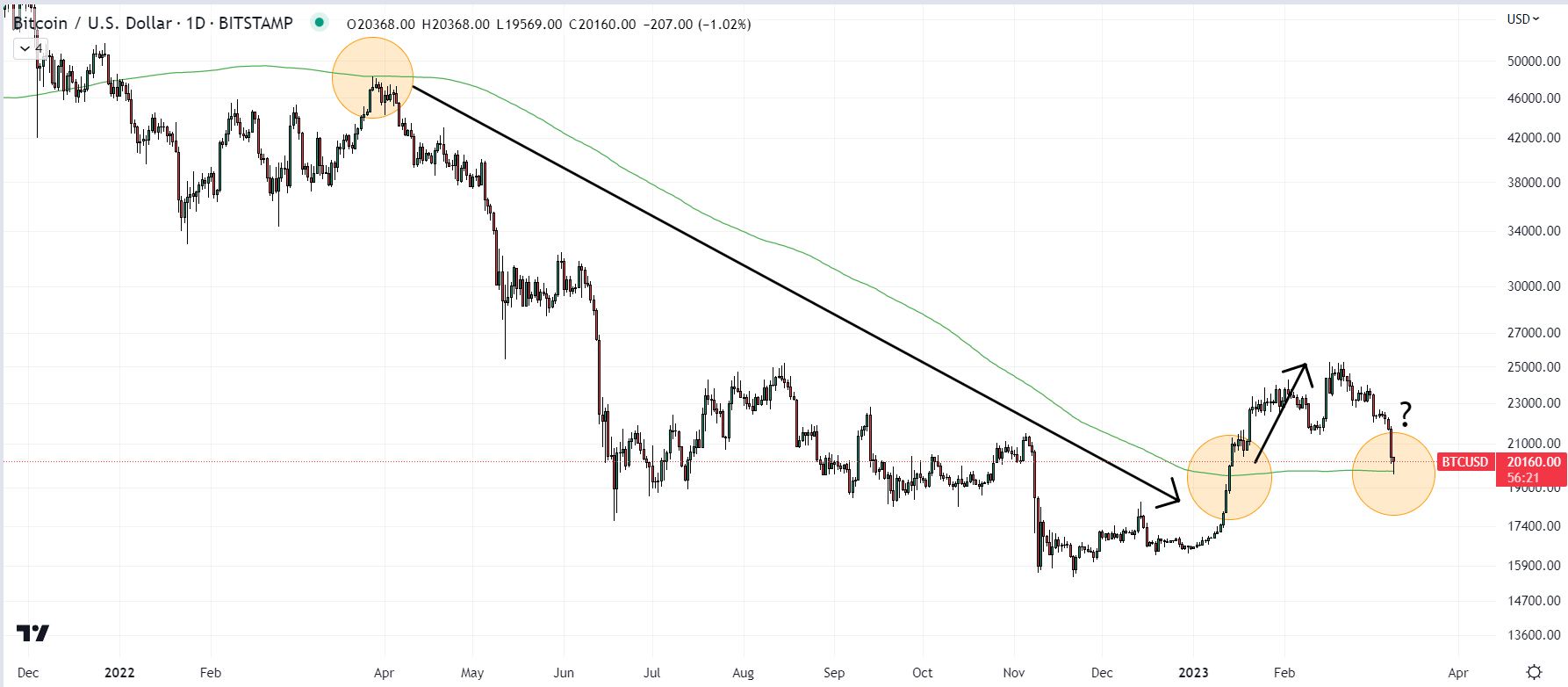
Macro Headwinds Remain
Despite the strong bounce on Friday from key support, price risks remain tilted to the downside, as macro risks grow. US equity markets tumbled this week, led by an aggressive sell-off in bank stocks as two crypto/tech start-up-linked US banks (Silvergate and Silicon Valley Bank) imploded.
Both eventually succumbed to bank runs, with depositors (including many crypto and tech firms) worrying about the strength of their balance sheets. Silicon Valley Bank’s woes were worsened by a failed attempt to raise capital earlier this week that drew attention to the horrible state of its bond portfolio.
The risk of contagion to other small and medium-sized US banks remains elevated and this could keep risk appetite in stock and crypto markets on the ropes next week.
Friday’s not-as-hot-as-feared US jobs report and troubles in the bank sector have led markets to wind back Fed tightening bets, with a 25 bps rate hike from the US central bank later this month now once again the market’s base case assumption.
But next week sees the release of the February US CPI report. If this shows that the resurgence in price pressures seen in January continued to build in February, markets may once again be forced to price in a 50 bps rate hike later this month, as well as a possibly higher terminal rate.
That would be toxic for risks assets at a time when concerns are elevated about the impact of the Fed’s tightening efforts on the banking sector, and could worsen the contagion already being seen.
Risks Remain Tilted to the Downside
One area of concern specifically for crypto is USDC stablecoin issuer Circle’s reserves, a small portion of which were held at Silicon Valley Bank. At the moment, it seems as though all deposits will be made whole.
But if there is any inkling that the unfolding US banking crisis has caused Circle to lose some of its reserves, this could create a crisis in crypto as investors rush to sell their USDC.
For all of the above-noted reasons, as well as ongoing jitters about the ongoing crypto crackdown by US regulators (the NY attorney general this week argued that Ether is a security), risks remain tilted to the downside. If Bitcoin loses a grip on the 200DMA and Realized Price, a swift dump to the support-turned-resistance $18,200-400 area could be in store.
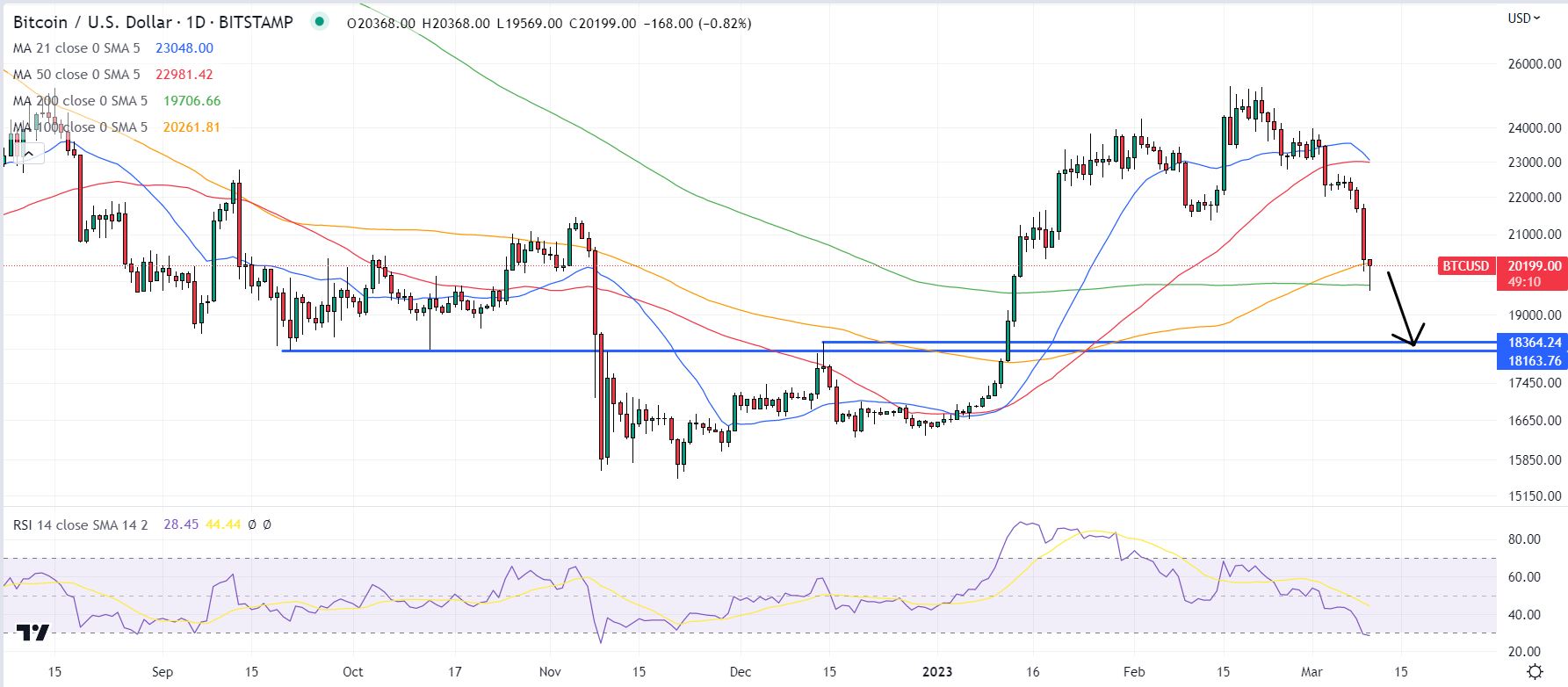
After falling another 1% on Friday to take its week-to-date losses above 10%, Bitcoin (BTC) is now oversold, according to the widely followed 14-Day Relative Strength Index (RSI) indicator. BTC/USD was last changing hands in the $20,100s, having dipped as low as the $19,500s earlier in the session, with its RSI last just above 28.

An RSI score of less than 30 is widely viewed as indicating that market conditions have become oversold in the short term. Meanwhile, an RSI score of above 70 is viewed as indicating market conditions have become over-bought.
The last time Bitcoin’s RSI fell below 30 was in the immediate aftermath of the collapse of cryptocurrency exchange FTX back in November. Bitcoin’s RSI entering oversold territory is often a lead indicator that a recent sharp drop may be about to end and a period of consolidation at lower price levels may be incoming.

Bitcoin’s RSI falling into oversold territory comes after a so-called “bearish divergence” earlier in the year. This is where the RSI starts posting lower highs, despite prices remaining in an uptrend.
In the most recent example, Bitcoin’s RSI hit a high of 86 on the 13th of January when BTC/USD was just breaking above $20,000, before continually posting lower highs as the Bitcoin price advanced above $25,000 over the course of the next few weeks.

Some traders view a bearish divergence of the RSI with the underlying price as an indicator that bullish price momentum is waning. And that certainly seems to have been the case in the last few weeks.
200DMA, Realized Price Offer Vital Support
Bitcoin’s bounce back above the $20,000 level on Friday suggests appetite in the market to defend the key 200-Day Moving Average and Realized Price levels in the $19,700-800 region remains strong.

For reference, the Realized Price is an on-chain metric, calculated by taking the average price at the time when each circulating Bitcoin last moved – it’s a proxy for the average price the market paid for each Bitcoin.
Both levels are widely followed by cryptocurrency and traditional asset investors alike. A decisive break above these levels, as happened earlier in the year, is seen as a strong sign that the market’s near-term momentum has shifted in a positive direction.
Conversely, failure to break above the 200DMA (or Realized Price) can be viewed as a sign that the market “isn’t ready” to embark on a new bullish trend, and aggressive reversals are often seen. That was the case for Bitcoin when it failed to break above its 200DMA back in late March 2022.

Macro Headwinds Remain
Despite the strong bounce on Friday from key support, price risks remain tilted to the downside, as macro risks grow. US equity markets tumbled this week, led by an aggressive sell-off in bank stocks as two crypto/tech start-up-linked US banks (Silvergate and Silicon Valley Bank) imploded.
Both eventually succumbed to bank runs, with depositors (including many crypto and tech firms) worrying about the strength of their balance sheets. Silicon Valley Bank’s woes were worsened by a failed attempt to raise capital earlier this week that drew attention to the horrible state of its bond portfolio.
The risk of contagion to other small and medium-sized US banks remains elevated and this could keep risk appetite in stock and crypto markets on the ropes next week.
Friday’s not-as-hot-as-feared US jobs report and troubles in the bank sector have led markets to wind back Fed tightening bets, with a 25 bps rate hike from the US central bank later this month now once again the market’s base case assumption.
But next week sees the release of the February US CPI report. If this shows that the resurgence in price pressures seen in January continued to build in February, markets may once again be forced to price in a 50 bps rate hike later this month, as well as a possibly higher terminal rate.
That would be toxic for risks assets at a time when concerns are elevated about the impact of the Fed’s tightening efforts on the banking sector, and could worsen the contagion already being seen.
Risks Remain Tilted to the Downside
One area of concern specifically for crypto is USDC stablecoin issuer Circle’s reserves, a small portion of which were held at Silicon Valley Bank. At the moment, it seems as though all deposits will be made whole.
But if there is any inkling that the unfolding US banking crisis has caused Circle to lose some of its reserves, this could create a crisis in crypto as investors rush to sell their USDC.
For all of the above-noted reasons, as well as ongoing jitters about the ongoing crypto crackdown by US regulators (the NY attorney general this week argued that Ether is a security), risks remain tilted to the downside. If Bitcoin loses a grip on the 200DMA and Realized Price, a swift dump to the support-turned-resistance $18,200-400 area could be in store.
